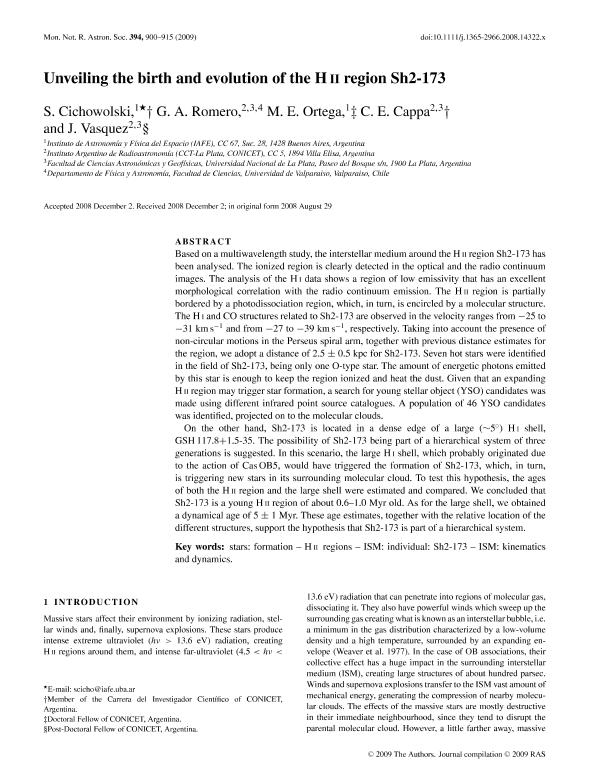Mostrar el registro sencillo del ítem
dc.contributor.author
Cichowolski, Silvina

dc.contributor.author
Romero, Gisela Andrea

dc.contributor.author
Ortega, Martin Eduardo

dc.contributor.author
Cappa, Cristina Elisabeth

dc.contributor.author
Vasquez, J.
dc.date.available
2017-09-25T18:29:13Z
dc.date.issued
2009-04
dc.identifier.citation
Cichowolski, Silvina; Romero, Gisela Andrea; Ortega, Martin Eduardo; Cappa, Cristina Elisabeth; Vasquez, J.; Unveiling the birth and evolution of the HII region Sh2-173; Oxford University Press; Monthly Notices of the Royal Astronomical Society; 394; 2; 4-2009; 900-915
dc.identifier.issn
0035-8711
dc.identifier.uri
http://hdl.handle.net/11336/25051
dc.description.abstract
Based on a multiwavelength study, the interstellar medium around the H II region Sh2-173 has been analysed. The ionized region is clearly detected in the optical and the radio continuum images. The analysis of the H I data shows a region of low emissivity that has an excellent morphological correlation with the radio continuum emission. The H II region is partially bordered by a photodissociation region, which, in turn, is encircled by a molecular structure. The H I and CO structures related to Sh2-173 are observed in the velocity ranges from −25 to −31 km s−1 and from −27 to −39 km s−1, respectively. Taking into account the presence of non-circular motions in the Perseus spiral arm, together with previous distance estimates for
the region, we adopt a distance of 2.5 ± 0.5 kpc for Sh2-173. Seven hot stars were identified in the field of Sh2-173, being only one O-type star. The amount of energetic photons emitted by this star is enough to keep the region ionized and heat the dust. Given that an expanding H II region may trigger star formation, a search for young stellar object (YSO) candidates was made using different infrared point source catalogues. A population of 46 YSO candidates was identified, projected on to the molecular clouds. On the other hand, Sh2-173 is located in a dense edge of a large (∼5◦) H I shell, GSH 117.8+1.5-35. The possibility of Sh2-173 being part of a hierarchical system of three generations is suggested. In this scenario, the large H I shell, which probably originated due to the action of Cas OB5, would have triggered the formation of Sh2-173, which, in turn, is triggering new stars in its surrounding molecular cloud. To test this hypothesis, the ages
of both the H II region and the large shell were estimated and compared. We concluded that Sh2-173 is a young H II region of about 0.6–1.0 Myr old. As for the large shell, we obtained a dynamical age of 5 ± 1 Myr. These age estimates, together with the relative location of the different structures, support the hypothesis that Sh2-173 is part of a hierarchical system.
dc.format
application/pdf
dc.language.iso
eng
dc.publisher
Oxford University Press

dc.rights
info:eu-repo/semantics/openAccess
dc.rights.uri
https://creativecommons.org/licenses/by-nc-sa/2.5/ar/
dc.subject
Stars: Formation
dc.subject
Hii Regions
dc.subject
Ism: Individual: Sh2-173
dc.subject
Ism: Kinematics And Dynamics
dc.subject.classification
Astronomía

dc.subject.classification
Ciencias Físicas

dc.subject.classification
CIENCIAS NATURALES Y EXACTAS

dc.title
Unveiling the birth and evolution of the HII region Sh2-173
dc.type
info:eu-repo/semantics/article
dc.type
info:ar-repo/semantics/artículo
dc.type
info:eu-repo/semantics/publishedVersion
dc.date.updated
2017-09-21T18:02:29Z
dc.journal.volume
394
dc.journal.number
2
dc.journal.pagination
900-915
dc.journal.pais
Reino Unido

dc.journal.ciudad
Londres
dc.description.fil
Fil: Cichowolski, Silvina. Consejo Nacional de Investigaciónes Científicas y Técnicas. Oficina de Coordinación Administrativa Ciudad Universitaria. Instituto de Astronomía y Física del Espacio. - Universidad de Buenos Aires. Facultad de Ciencias Exactas y Naturales. Instituto de Astronomía y Física del Espacio; Argentina
dc.description.fil
Fil: Romero, Gisela Andrea. Provincia de Buenos Aires. Gobernación. Comisión de Investigaciones Científicas. Instituto Argentino de Radioastronomía. Consejo Nacional de Investigaciones Científicas y Técnicas. Centro Científico Tecnológico Conicet - La Plata. Instituto Argentino de Radioastronomía; Argentina. Consejo Nacional de Investigaciones Científicas y Técnicas. Centro Científico Tecnológico Conicet - La Plata. Instituto de Astrofísica La Plata. Universidad Nacional de La Plata. Facultad de Ciencias Astronómicas y Geofísicas. Instituto de Astrofísica la Plata; Argentina. Pontificia Universidad Catolica de Valparaiso; Chile
dc.description.fil
Fil: Ortega, Martin Eduardo. Consejo Nacional de Investigaciónes Científicas y Técnicas. Oficina de Coordinación Administrativa Ciudad Universitaria. Instituto de Astronomía y Física del Espacio. - Universidad de Buenos Aires. Facultad de Ciencias Exactas y Naturales. Instituto de Astronomía y Física del Espacio; Argentina
dc.description.fil
Fil: Cappa, Cristina Elisabeth. Provincia de Buenos Aires. Gobernación. Comisión de Investigaciones Científicas. Instituto Argentino de Radioastronomía. Consejo Nacional de Investigaciones Científicas y Técnicas. Centro Científico Tecnológico Conicet - La Plata. Instituto Argentino de Radioastronomía; Argentina. Universidad Nacional de la Plata. Facultad de Ciencias Astronómicas y Geofísicas; Argentina
dc.description.fil
Fil: Vasquez, J.. Provincia de Buenos Aires. Gobernación. Comisión de Investigaciones Científicas. Instituto Argentino de Radioastronomía. Consejo Nacional de Investigaciones Científicas y Técnicas. Centro Científico Tecnológico Conicet - La Plata. Instituto Argentino de Radioastronomía; Argentina. Universidad Nacional de la Plata. Facultad de Ciencias Astronómicas y Geofísicas; Argentina
dc.journal.title
Monthly Notices of the Royal Astronomical Society

dc.relation.alternativeid
info:eu-repo/semantics/altIdentifier/doi/http://dx.doi.org/10.1111/j.1365-2966.2008.14322.x
dc.relation.alternativeid
info:eu-repo/semantics/altIdentifier/url/https://academic.oup.com/mnras/article-lookup/doi/10.1111/j.1365-2966.2008.14322.x
Archivos asociados
